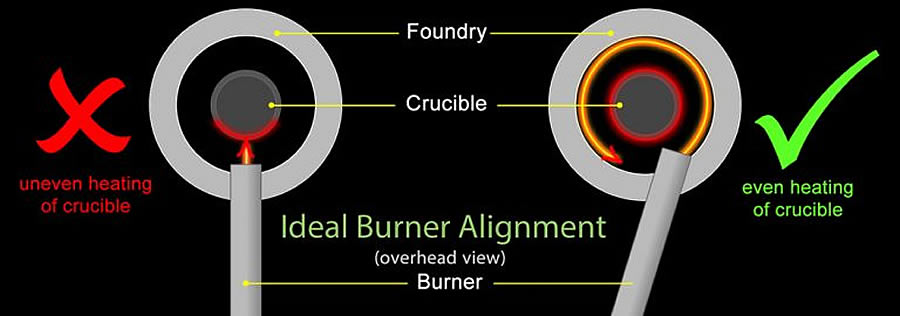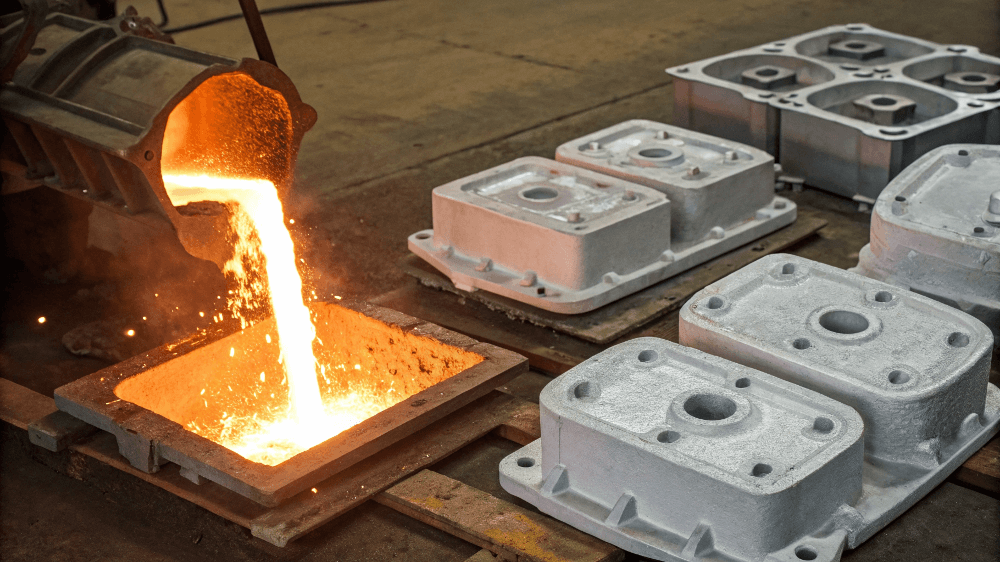Aluminum Foundry Wisconsin is a essential partner in casting solutions
Wiki Article
How Aluminum Foundry Adds to Innovations in Aerospace Engineering
Aluminum foundries are important to improvements in aerospace engineering. They create light-weight, high-strength elements that are vital for modern-day aircraft. With sophisticated casting methods, these shops produce complicated geometries that enhance structural integrity. Furthermore, the growth of premium Aluminum alloys supports the sector's focus on fuel effectiveness and sustainability. Nevertheless, difficulties remain in the production procedure. Comprehending these factors reveals the profound impact of Aluminum on aeronautics's future.The Relevance of Lightweight Products in Aerospace Style
As the aerospace sector remains to progress, the value of lightweight materials becomes progressively evident. The demand for efficiency and sustainability drives designers to focus on making use of products that reduce overall weight without compromising architectural stability. Lightweight materials, especially Aluminum, play an important role in boosting fuel effectiveness, improving payload capacity, and enhancing the general efficiency of airplane.Additionally, the integration of these materials allows for cutting-edge designs, making it possible for manufacturers to create more wind resistant shapes that can hold up against extreme conditions. The decrease in weight not only decreases operational costs however additionally adds to a decreased ecological impact, aligning with worldwide initiatives towards sustainability in aeronautics.
Advanced Spreading Techniques in Aluminum Foundries
Advanced casting methods in Aluminum foundries play an essential role in aerospace design by allowing the production of light-weight and precise elements. Advancements in mold and mildew layout and accuracy spreading processes are essential in accomplishing suitable performance and structural honesty. Additionally, the growth of light-weight alloys boosts the total efficiency and effectiveness of aerospace applications.Cutting-edge Mold And Mildew Layout
Ingenious mold and mildew style plays a crucial function in the effectiveness and effectiveness of Aluminum factories, specifically within the aerospace sector. By leveraging innovative products and techniques, modern molds can be engineered to stand up to heats and stress, ensuring peak efficiency during the spreading process. These designs typically incorporate intricate geometries that enable the manufacturing of light-weight yet structurally sound parts, necessary for aerospace applications. In addition, the usage of computer-aided design (CAD) software program facilitates specific modeling, making it possible for factories to refine and imitate mold layouts prior to physical manufacturing begins. This not only improves the quality of actors components yet also decreases waste and lead times, bring about considerable expense financial savings. Generally, innovative mold layout is a foundation of progress in Aluminum Foundry innovation for aerospace engineering.Precision Casting Processes
The efficiency of cutting-edge mold and mildew layouts perfectly integrates with accuracy casting processes, which are vital for creating premium Aluminum elements in aerospace engineering. These processes, including sand spreading, die spreading, and financial investment casting, guarantee the creation of complex geometries with limited resistances. Advanced techniques like vacuum cleaner casting and stress die casting improve the integrity and surface area finish of the last products. Precision casting lessens material waste while optimizing the mechanical residential or commercial properties of Aluminum, crucial for aerospace applications. Furthermore, using real-time tracking and progressed simulation devices throughout the casting procedure allows for immediate changes, leading to improved quality assurance. Collectively, these accuracy spreading processes placement Aluminum factories at the forefront of aerospace advancement, supporting the market's need for dependability and performance.Lightweight Alloy Development
As aerospace designers look for to boost gas performance and efficiency, light-weight alloy growth comes to be a necessary emphasis in Aluminum factories. These shops use sophisticated spreading techniques to produce alloys that provide remarkable strength-to-weight ratios. Developments in alloy composition, consisting of the incorporation of components like lithium and magnesium, make it possible for the production of materials that endure extreme conditions while minimizing total aircraft weight. Methods such as die casting and financial investment spreading facilitate the precision manufacturing of complex forms, which are crucial for aerospace applications. Additionally, ongoing research intends to optimize these alloys for enhanced mechanical buildings and raised durability. By focusing on lightweight alloy growth, Aluminum factories significantly add to the advancement of aerospace design, leading the way for a lot more reliable and lasting aircraft styles.
Enhancing Architectural Stability Through Aluminum Parts
Aluminum components supply substantial advantages in boosting structural stability within aerospace design. Their light-weight nature adds to total effectiveness while keeping toughness, which is important for airplane performance. In addition, the stress and anxiety resistance buildings of Aluminum help guarantee the durability and integrity of aerospace structures under numerous functional problems.
Light-weight Material Conveniences
While conventional products usually compromise weight for strength, using Aluminum components in aerospace engineering provides considerable benefits in structural honesty. Aluminum's light-weight nature adds to total layout efficiency, enabling for even more streamlined aircraft that take in much less fuel, thereby boosting sustainability. The product's outstanding strength-to-weight proportion guarantees that parts keep longevity without including unneeded mass. This top quality promotes enhanced efficiency and dexterity in flight, in addition to optimized haul capabilities. Additionally, Aluminum's resistance to rust extends the life expectancy of aerospace structures, reducing maintenance costs and enhancing safety and security. As suppliers significantly embrace Aluminum alloys, the aerospace industry experiences a transformative shift in the direction of extra reliable and effective engineering solutions that prioritize both performance and environmental obligation.Anxiety Resistance Features
Although numerous products have unique homes, Aluminum's remarkable tension resistance attracts attention as an essential consider improving the structural integrity of aerospace elements. This resistance plays a critical function in ensuring that airplane can endure different functional stresses, consisting of exhaustion, impact, and ecological problems. Aluminum alloys, particularly engineered for aerospace applications, show high tensile strength while maintaining lightweight characteristics, allowing designers to design much more effective structures - Aluminum Foundry. Additionally, the capacity of Aluminum to endure cyclic loading without substantial contortion contributes to the durability and reliability of aerospace components. As innovations proceed in Aluminum Foundry methods, the advancement of stress-resistant Aluminum elements guarantees more improvements in efficiency, safety, and efficiency throughout the news aerospace industry, solidifying Aluminum's function as a recommended product in modern-day engineeringFuel Performance Improvements Driven by Aluminum Innovations
As the aerospace market seeks to enhance fuel efficiency, innovative uses of Aluminum have actually emerged as a necessary option. Aluminum's lightweight nature notably lowers airplane weight, allowing for reduced fuel intake throughout flight. This reduction in weight is crucial, as also little decreases can cause substantial enhancements in overall fuel economy.Advanced Aluminum alloys, made for improved strength and durability, allow manufacturers to create elements that keep structural honesty while reducing mass - Aluminum Foundry. In addition, the integration of Aluminum in airframes and engine parts assists in boosted aerodynamics, adding to minimized drag and raised effectiveness
The fostering of Aluminum in aerospace not just fulfills the need for fuel-efficient layout but likewise aligns with governing stress for reduced discharges. As these innovations proceed to advance, they play a significant function in setting brand-new benchmarks for gas efficiency, making sure that the aerospace sector can meet growing ecological and economic difficulties.

The Duty of Aluminum in Sustainable Aviation Practices
The raising emphasis on lasting aviation practices has actually placed Aluminum as a vital product in the mission for greener aircraft design. Understood for its light-weight properties, Aluminum significantly decreases airplane weight, causing lower gas consumption and exhausts. Its recyclability additionally enhances its sustainability account, as Aluminum can be recycled indefinitely without loss of top quality. This particular sustains a circular economic situation within the air travel field, decreasing waste and resource depletion.Advancements in Aluminum alloys have improved their toughness and rust resistance, permitting for longer solution life and lowered upkeep requirements. These innovations assist in the development of much more reliable airplane frameworks, adding to total sustainability initiatives. Furthermore, Aluminum's thermal conductivity plays a critical function in energy-efficient layouts, improving systems such as heat exchangers. Jointly, these attributes emphasize Aluminum's crucial function in progressing sustainable aeronautics, straightening with international campaigns focused on decreasing the ecological impact of air traveling.
Obstacles Encountered by Aluminum Foundries in Aerospace Production
While Aluminum foundries play an important duty in aerospace production, they deal with significant obstacles that can impact production performance and top quality. One significant challenge is the rigorous high quality control standards required in the aerospace sector. Any flaw can compromise safety and security and performance, demanding rigorous examination processes that expand manufacturing timelines. Furthermore, foundries typically contend with varying resources expenses, which can impact rates and profitability. The complexity of Aluminum alloys made use of in aerospace applications further complicates the manufacturing process, as specific formulations are critical for accomplishing desired mechanical homes. Furthermore, knowledgeable labor lacks impede the capability to keep premium production degrees. Lastly, environmental laws impose limitations on discharges and waste management, needing factories to spend in lasting methods, which can be cost-prohibitive. These variables jointly produce a landscape where Aluminum shops have to continuously adapt to fulfill the advancing demands of aerospace production while ensuring safety and conformity.Future Fads in Aluminum Applications for Aerospace Design
With improvements in modern technology and boosting needs for effectiveness, the future of Aluminum applications in aerospace design is positioned visit our website for substantial improvement. The combination of ingenious Aluminum alloys and compounds is expected to improve strength-to-weight ratios, causing more fuel-efficient airplane styles. Additionally, advancements in additive production techniques will enable the manufacturing of intricate Aluminum structures that were formerly impossible, optimizing efficiency and reducing waste.
Lasting techniques will certainly play a crucial function, with an expanding focus on reusing Aluminum to decrease ecological effect. The aerospace sector is most likely to accept smarter manufacturing procedures, such as automation and expert system, guaranteeing higher quality and accuracy in Aluminum components. Collaborations between Aluminum foundries and aerospace business will certainly cultivate research and growth, leading the way for new applications that fulfill the strict demands of contemporary aerospace engineering. Overall, the future looks assuring for Aluminum's duty in shaping the skies
Frequently Asked Inquiries
What Are the Ecological Influences of Aluminum Production in Aerospace?
The ecological influences of Aluminum production in aerospace consist of considerable power usage, greenhouse gas discharges, and environment interruption. In addition, mining procedures can lead to dirt degradation and water contamination, elevating concerns concerning sustainability and environmental equilibrium.Exactly How Does Aluminum Compare to Other Materials in Aerospace Applications?
Aluminum uses an one-of-a-kind mix of lightweight residential or commercial properties, deterioration resistance, and cost-effectiveness contrasted to other products. Its high strength-to-weight proportion makes it especially useful for aerospace applications, boosting original site gas effectiveness and general performance in airplane style.What Credentials Do Aluminum Foundry Employees Requirement for Aerospace Projects?
Aluminum Foundry employees call for customized training in metallurgy and spreading strategies, in addition to understanding of aerospace market requirements. Certifications in quality assurance and safety and security protocols are additionally important to assure conformity with strict aerospace project demands.Exist Any Type Of Safety And Security Concerns With Making Use Of Aluminum in Aerospace Design?
Security issues pertaining to Aluminum in aerospace design include sensitivity to tension, rust, and tiredness cracks. Proper therapy and alloy selection are necessary to minimize these risks, making sure structural integrity and overall safety and security in aerospace applications.Just How Does Aluminum Recycling Benefit the Aerospace Market?
Aluminum recycling substantially profits the aerospace market by decreasing material expenses, decreasing environmental impact, and preserving energy. This lasting practice enhances the industry's performance while promoting the usage of light-weight, high-performance parts in airplane production.Advanced spreading strategies in Aluminum foundries play a crucial duty in aerospace design by enabling the manufacturing of light-weight and accurate parts. Ingenious mold and mildew design plays an essential role in the effectiveness and performance of Aluminum shops, specifically within the aerospace sector. As aerospace designers look for to enhance fuel effectiveness and efficiency, lightweight alloy development ends up being a vital focus in Aluminum factories. Aluminum alloys, specifically engineered for aerospace applications, show high tensile stamina while preserving lightweight characteristics, enabling engineers to make much more reliable frameworks. Cooperations in between Aluminum factories and aerospace firms will foster study and growth, leading the means for brand-new applications that meet the rigorous requirements of contemporary aerospace engineering.
Report this wiki page